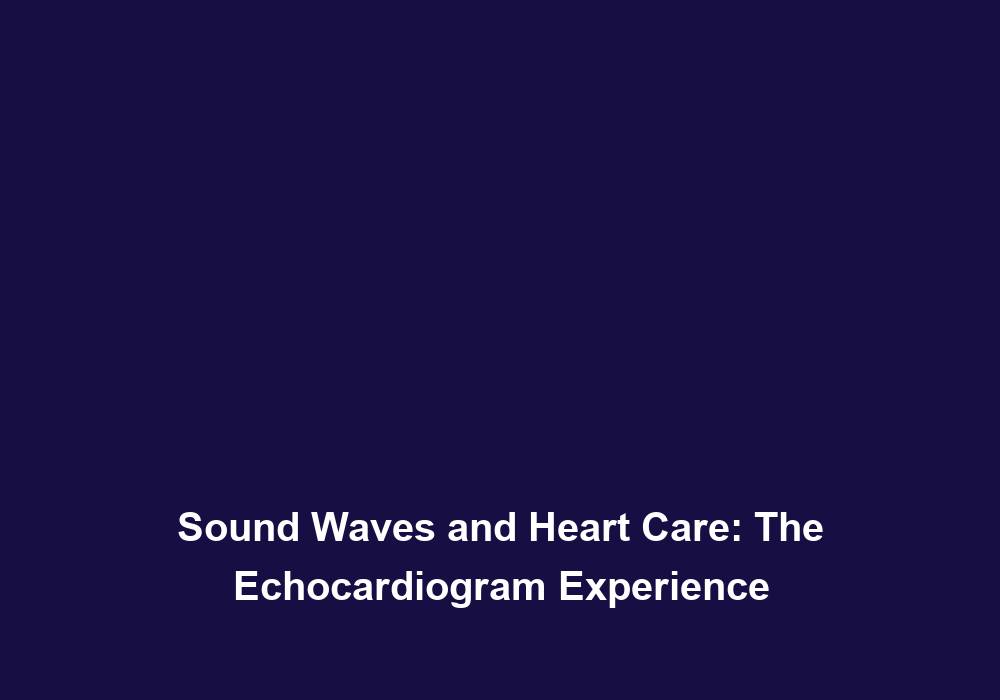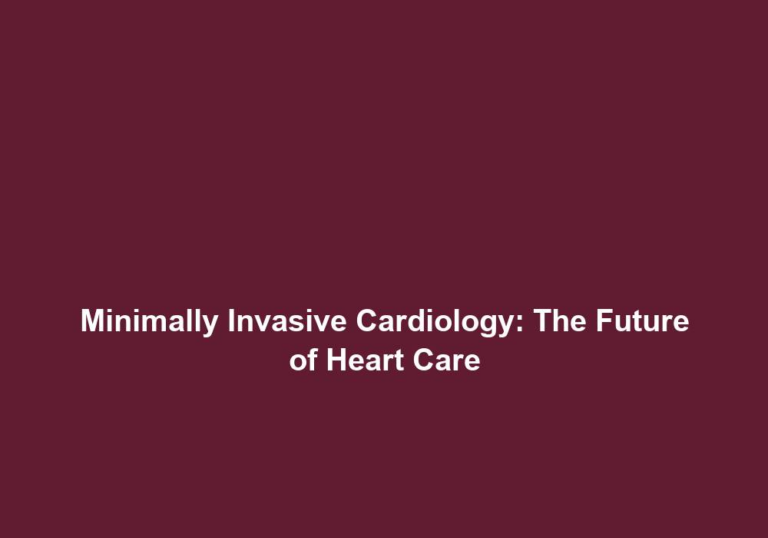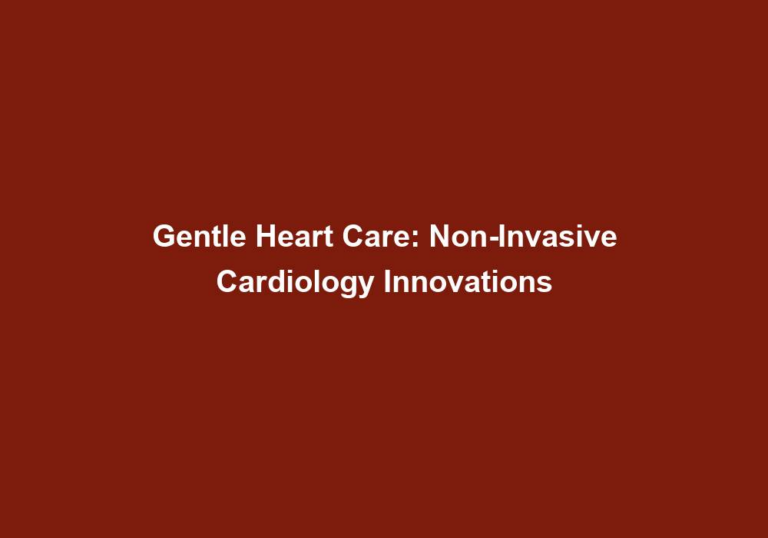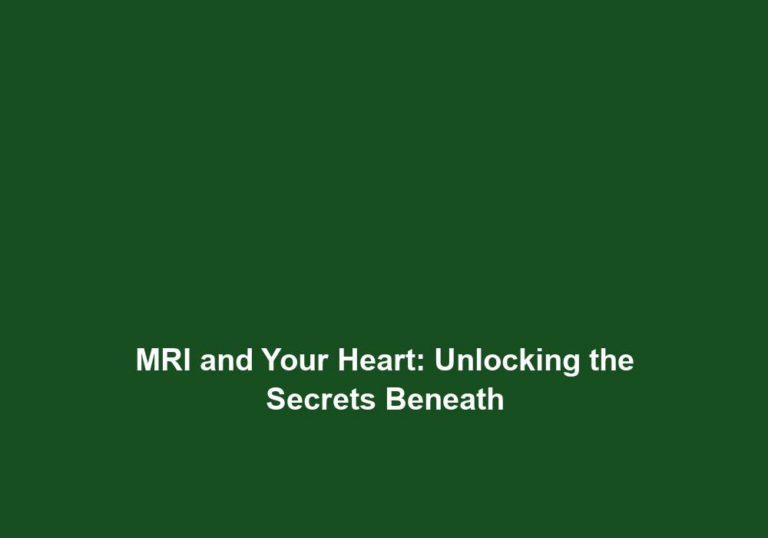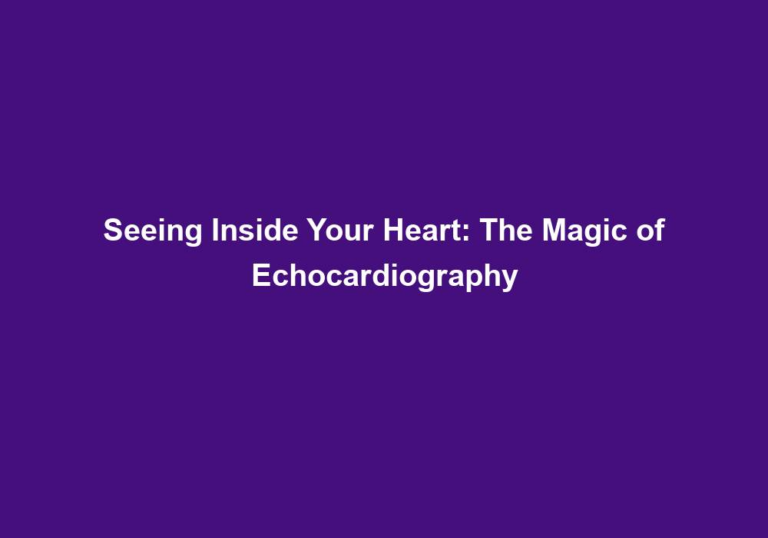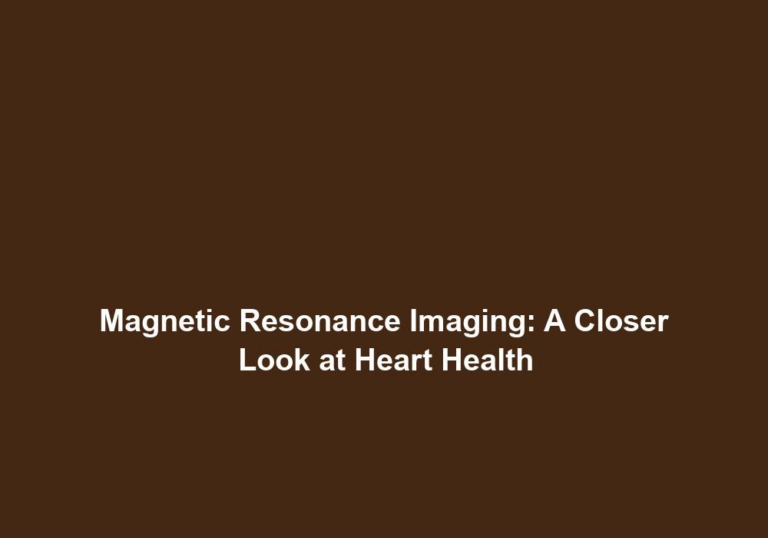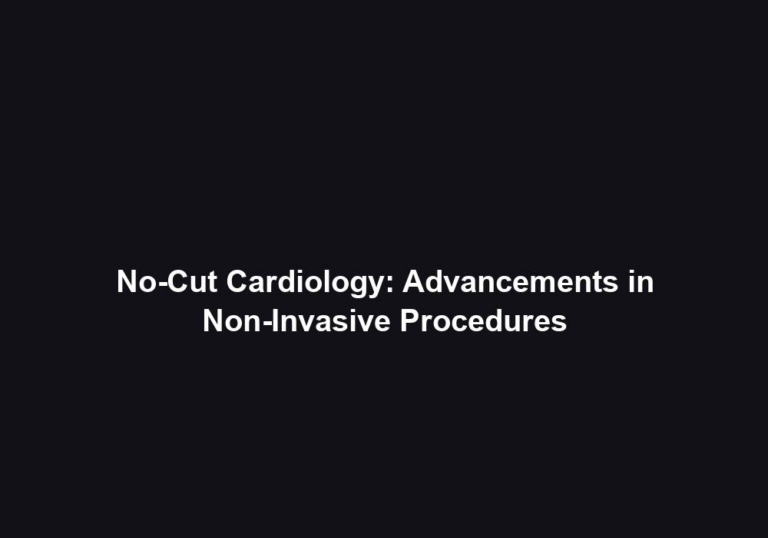Sound Waves and Heart Care: The Echocardiogram Experience
An echocardiogram, also referred to as a cardiac ultrasound or simply an echo, is a non-invasive medical test that helps healthcare professionals visualize and assess the structure and function of the heart. By using high-frequency sound waves or ultrasound, an echocardiogram enables detailed imaging of the heart, providing valuable information for diagnosing and managing various heart conditions. In this article, we will delve into the intricacies of echocardiograms, their benefits, and what to expect during the procedure.
Understanding Echocardiography
Echocardiography involves the use of a transducer, a small handheld device that emits ultrasound waves, to capture images of the heart. These sound waves bounce off the various structures within the heart and return to the transducer, which then converts them into detailed images displayed on a monitor. The images produced are known as echocardiograms.
The primary purpose of an echocardiogram is to evaluate the heart’s size, shape, and pumping function. It can also provide valuable insights into the condition of the heart valves, chambers, and blood flow patterns. By assessing these aspects, cardiologists and healthcare professionals can diagnose and monitor conditions such as heart failure, valve diseases, congenital heart defects, and other abnormalities.
How Does Echocardiography Work?
During an echocardiogram, the transducer is placed on the chest wall and moved around gently to capture images of the heart from different angles. The sound waves emitted by the transducer penetrate the chest and bounce back when they encounter different tissues and structures within the heart. These echoes are then converted into detailed images, allowing healthcare professionals to visualize the heart and assess its function.
The images produced by echocardiography can provide valuable information about the heart’s size, shape, and the thickness of its walls. This information helps in evaluating the heart’s pumping function, detecting any abnormalities in the heart valves, and assessing the blood flow patterns within the heart. By analyzing these images, cardiologists can make accurate diagnoses and develop appropriate treatment plans.
Types of Echocardiograms
There are different types of echocardiograms, each catering to specific diagnostic needs. Let’s explore some of the commonly used types:
- Transthoracic Echocardiogram (TTE): This is the most common type of echocardiogram, which involves placing the transducer on the chest wall to capture images of the heart. TTE provides a comprehensive evaluation of the heart’s structure and function and is usually the initial step in diagnosing heart conditions.
During a TTE, the transducer is moved to different locations on the chest to obtain images of the heart from various angles. This allows healthcare professionals to assess the heart’s size, shape, and pumping function accurately. TTE is a non-invasive procedure that provides valuable information for diagnosing conditions such as heart failure, valve diseases, and congenital heart defects.
- Transesophageal Echocardiogram (TEE): In certain cases, a more detailed assessment is required, which is where TEE comes into play. During a TEE, a specialized transducer is inserted into the esophagus, providing clearer and closer images of the heart. This type of echocardiogram is commonly used to evaluate heart valve diseases, blood clots, and infections.
TEE allows healthcare professionals to obtain high-resolution images of the heart, as the transducer is positioned closer to the heart. This procedure is often performed under sedation to ensure patient comfort. TEE is particularly useful for assessing the structure and function of the heart valves, detecting blood clots, and evaluating infective endocarditis.
- Stress Echocardiogram: By combining echocardiography with exercise or medication-induced stress, healthcare professionals can evaluate how the heart performs under physical exertion. This type of echocardiogram helps identify abnormalities in blood flow and heart function during stress, aiding in the diagnosis of coronary artery disease and determining exercise capacity.
During a stress echocardiogram, the patient is either asked to exercise on a treadmill or given medications to mimic the effects of exercise on the heart. The echocardiogram is performed before and after the stress-inducing activity to compare the heart’s function at rest and during stress. This procedure can help identify areas of the heart with reduced blood flow, indicating the presence of coronary artery disease.
Benefits of Echocardiograms
Echocardiograms offer several benefits for both patients and healthcare professionals. Some of the key advantages include:
- Non-Invasiveness: Unlike certain diagnostic procedures that require invasive techniques, echocardiograms are entirely non-invasive, posing minimal risk to patients. They eliminate the need for surgical incisions, making them safe and well-tolerated by individuals of all ages.
Echocardiograms are performed externally, without the need for any incisions or injections. This non-invasive nature of the procedure ensures patient comfort and safety. It also allows for repeated echocardiograms to monitor the progression of heart conditions over time.
- Accurate Diagnosis: Echocardiography provides highly accurate and detailed images of the heart. This allows healthcare professionals to assess various aspects, such as heart size, function, and blood flow patterns, with precision. Accurate diagnosis plays a crucial role in formulating effective treatment plans.
The detailed images obtained through echocardiography enable healthcare professionals to make accurate diagnoses. By assessing the heart’s structure, function, and blood flow patterns, cardiologists can identify abnormalities and develop appropriate treatment plans tailored to each patient’s specific needs.
- Real-Time Evaluation: Echocardiograms offer real-time evaluation of the heart, allowing healthcare professionals to monitor the heart’s function as it beats. This dynamic assessment provides valuable information about any abnormalities or changes in heart function, enabling prompt intervention when necessary.
The real-time evaluation provided by echocardiograms allows healthcare professionals to assess the heart’s function during the procedure itself. This real-time monitoring helps detect any abnormalities or changes in heart function, allowing for immediate intervention if required.
- Versatility: Echocardiograms can be utilized for diagnosing and monitoring a wide range of heart conditions, from congenital abnormalities to acquired heart diseases. The versatility of echocardiography makes it an essential tool in the field of cardiology.
Echocardiography is a versatile diagnostic tool that can be used to assess various heart conditions. It is particularly useful in diagnosing and monitoring conditions such as heart failure, valve diseases, congenital heart defects, and infections. The ability to obtain detailed images of the heart makes echocardiography an invaluable tool for cardiologists and other healthcare professionals.
The Echocardiogram Experience
Undergoing an echocardiogram is a straightforward and painless procedure that typically takes around 30 to 60 minutes to complete. Here is a step-by-step guide on what to expect during the echocardiogram experience:
- Preparation: In most cases, no special preparation is required for a standard transthoracic echocardiogram. However, if a transesophageal echocardiogram is necessary, you may be asked to fast for a few hours before the procedure.
Before the echocardiogram, you may be asked to remove any clothing or jewelry that may interfere with the procedure. For a transthoracic echocardiogram, there is usually no need for fasting or any specific preparation. However, if a transesophageal echocardiogram is scheduled, you may be asked to avoid eating or drinking for a few hours before the procedure.
- Arrival and Setup: Upon arrival at the healthcare facility, a trained ultrasound technician or sonographer will guide you to the examination room. You will be asked to remove your clothing from the waist up and wear a hospital gown. Electrodes or sticky patches will be placed on your chest to monitor your heart’s electrical activity during the procedure.
Once you are in the examination room, the sonographer will provide instructions on how to prepare for the echocardiogram. This may involve changing into a hospital gown and removing any clothing or accessories that may interfere with the procedure. The sonographer will also attach electrodes or sticky patches to your chest to monitor your heart’s electrical activity during the echocardiogram.
- Transducer Placement: The sonographer will apply a gel-like substance on your chest to facilitate the movement of the transducer. They will then gently maneuver the transducer across different areas of your chest, capturing images from various angles. The sonographer may also ask you to change positions or hold your breath briefly to obtain specific images.
Once you are prepared, the sonographer will apply a gel-like substance on your chest. This gel helps improve contact between the transducer and your skin, allowing for better image quality. The sonographer will then move the transducer across different areas of your chest, capturing images of the heart from various angles. During the procedure, the sonographer may ask you to change positions or hold your breath briefly to obtain specific images.
- Image Interpretation: As the sonographer captures the images, they will analyze and interpret the findings in real-time. In some cases, a cardiologist may be present or review the images later to provide a more detailed assessment and diagnosis.
While performing the echocardiogram, the sonographer will analyze the images in real-time. They will assess the heart’s structure, function, and blood flow patterns, looking for any abnormalities or signs of heart conditions. In some cases, a cardiologist may be present during the procedure or review the images later to provide a more detailed assessment and diagnosis.
- Completion and Follow-Up: Once the echocardiogram is complete, the sonographer will clean off the gel from your chest. You can resume your normal activities immediately after the procedure, as there are no specific restrictions or recovery period involved. A follow-up appointment may be scheduled to discuss the results and any necessary treatment plans.
After the echocardiogram, the sonographer will clean off the gel from your chest. You can then get dressed and resume your normal activities immediately. The results of the echocardiogram will be reviewed by a cardiologist, who will provide a detailed report to your healthcare provider. A follow-up appointment may be scheduled to discuss the results and any necessary treatment plans.
Conclusion
Echocardiograms are invaluable tools in the field of cardiology, enabling healthcare professionals to visualize and evaluate the heart’s structure and function accurately. Through the use of sound waves or ultrasound, these non-invasive procedures offer a comprehensive assessment of the heart, aiding in the diagnosis and management of various heart conditions. By understanding the echocardiogram experience, patients can approach the procedure with confidence, knowing that it plays a vital role in their heart care journey.

